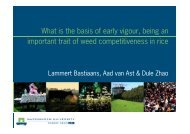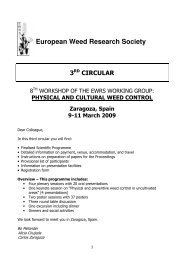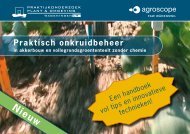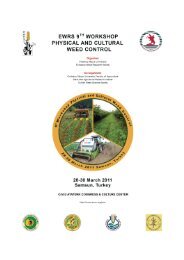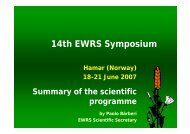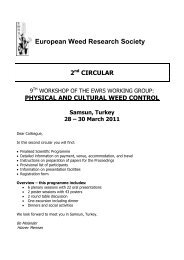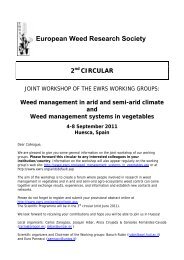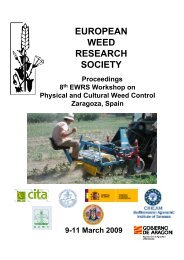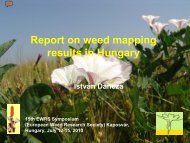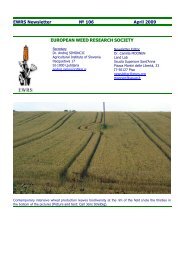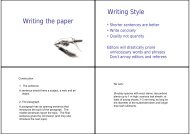Download - European Weed Research Society
Download - European Weed Research Society
Download - European Weed Research Society
You also want an ePaper? Increase the reach of your titles
YUMPU automatically turns print PDFs into web optimized ePapers that Google loves.
EWRS Newsletter № 117 January 2012<br />
EUROPEAN WEED RESEARCH SOCIETY<br />
Secretary<br />
Dr. Andrej SIMONČIČ<br />
Agricultural Institute of Slovenia<br />
Hacquetova 17<br />
SI-1000 Ljubljana<br />
andrej.simoncic@kis.si<br />
Newsletter Editor<br />
Dr. Camilla MOONEN<br />
Land Lab/Agroecology<br />
Institute of Life Sciences<br />
Scuola Superiore Sant’Anna<br />
Piazza Martiri della Libertà, 33<br />
IT-56127 Pisa<br />
newsletter@ewrs.org<br />
moonen@sssup.it<br />
Convolvulus arvensis L. in an organically grown wheat variety mix in the MASCOT trial at the Interdepartmental<br />
<strong>Research</strong> Station ‘E. Avanzi’ of the University of Pisa, Italy, in 2011, as part of the SOLIBAM (Strategies for Organic<br />
and Low-input Integrated Breeding and Management) project (Picture and text: Ambrogio Costanzo).
EWRS Newsletter № 117 January 2012<br />
CONTENTS<br />
Contents ............................................................................................................................. 2<br />
From the Board.................................................................................................................... 3<br />
President’s Message ................................................................................................................... 3<br />
Final Report of Elections for Board functions 2011 .......................................................................... 4<br />
Scientific Committee and Working Groups ............................................................................. 5<br />
A different kind of Workshop by the EWRS Working Group Site Specific <strong>Weed</strong> Management ............. 5<br />
Extract of the report on the 3 rd International Symposium on <strong>Weed</strong>s and Invasive Plants in Ascona,<br />
Switzerland ................................................................................................................................. 6<br />
Member contributions ........................................................................................................... 9<br />
New Spanish regulations regarding weed management .................................................................. 9<br />
Histology of Cardaria draba ........................................................................................................ 10<br />
Call for Conferences .......................................................................................................... 11<br />
25 th German Conference on <strong>Weed</strong> Biology and <strong>Weed</strong> Control ....................................................... 11<br />
7 th International IPM Symposium "IPM on the World Stage—Solutions for Global Pest Challenges" .. 11<br />
1 st International Conference on Robotics and associated High-technologies and Equipment for<br />
Agriculture (RHEA-2012): "Applications of automated systems and robotics for crop protection in<br />
sustainable precision agriculture” ................................................................................................ 11<br />
International Conference Global Herbicide Resistance Challenge 2013 .......................................... 12<br />
Upcoming Conferences and Workshops ...................................................................................... 13<br />
Editorial ............................................................................................................................. 15<br />
EWRS Board 2012–2013 ........................................................................................................... 15<br />
EWRS Scientific Committee 2012-2013 ....................................................................................... 16<br />
Instructions for Contributors ........................................................................................................ 17<br />
Charges for Job Advertising in the Newsletter .............................................................................. 17<br />
2
Dear colleagues and friends,<br />
EWRS Newsletter № 117 January 2012<br />
FROM THE BOARD<br />
PRESIDENT’S MESSAGE<br />
It is with great pleasure that I am taking over the duties of President from my<br />
predecessor Hansjörg Krähmer, whom I want to warmly thank. Hansjörg has<br />
served the EWRS with great passion and commitment. Among other things, I<br />
was amazed to see how he could put up a successful and active new Working<br />
Group (<strong>Weed</strong> Mapping) in such a short time! This makes me think that we<br />
should always beware of stereotypes. Many people would think that Presidents<br />
coming from the industry would commit to this task without much passion, being<br />
too much distracted by everyday company affairs. Well, I have rarely seen such<br />
a genuine enthusiasm and wholehearted commitment to the President tasks like<br />
that shared by the latest two Presidents we had from industry. We look forward<br />
to have a third one soon!<br />
But first I must acknowledge the election of our new Vice-President (and future President): Laszlo Radics<br />
from Corvinus University, Budapest, Hungary. Congratulations Laszlo, and welcome aboard. I also want<br />
to congratulate Ben Post and Andrej Simončič for their re-election as EWRS Treasurer and Board<br />
Secretary, respectively. You can find a full report of the 2011 election round at page 9. I also sincerely<br />
thank all the members who participated in the elections as candidates. Let me use this opportunity to<br />
invite our members to propose themselves as candidates in the next election round. Why not take the<br />
chance to see how the EWRS works directly from the control room?<br />
I am happy to serve our <strong>Society</strong> for the next two years and hope to contribute to maintaining, and<br />
possibly increasing, the high scientific recognition that the EWRS has reached worldwide. Much of this<br />
success depends on our Working Group-based structure. Through Working Group activities we can look<br />
at weeds and weed management from a plethora of observation points, something which is unrivalled<br />
worldwide. But any machine needs maintenance: that’s why we invite all of you to make full use of the<br />
opportunities our <strong>Society</strong> has to offer, be you a young research fellow, an experienced scientist, or a<br />
vegetation manager. Active members are the fuel and lubricant of the EWRS machine.<br />
This historical moment brings about many important challenges for science and society. The number of<br />
weed scientists is decreasing everywhere despite the fact that weeds are and will remain a major<br />
obstacle to crop production and the preservation of habitat quality. But we increasingly recognise that<br />
what we call ‘weeds’ can also contribute to the conservation of (functional) biodiversity and<br />
environmental quality. On a more practical side, in the EU we are facing a dramatic reduction in the<br />
availability of herbicides, and the new EU Framework Directive on Sustainable Pesticide Use will radically<br />
change the way crops will be grown. This will bring about undoubted challenges but also huge<br />
opportunities to improve our cropping and weed management systems. In this context, the role GM<br />
crops are going to play in EU agriculture is still uncertain and vastly debated.<br />
A few years ago I enjoyed writing an insight paper with some colleagues of mine (Fernandez-Quintanilla<br />
et al., <strong>Weed</strong> Res. 48, 297-301). I still think that many of the perspectives on the future of weed research<br />
we envisaged by looking through our crystal ball are still there and need someone to tackle them. I<br />
believe that weed scientists have the right mental flexibility to take on these new challenges. Wherever<br />
there are weeds – or someone caring/worried for them – there will be room for weed scientists. So let’s<br />
think positive and get ready for new opportunities.<br />
Ad majora!<br />
Paolo Bàrberi<br />
3<br />
Back to Content
EWRS Newsletter № 117 January 2012<br />
FINAL REPORT OF ELECTIONS FOR BOARD FUNCTIONS 2011<br />
Election procedure<br />
This is to inform you of the outcome of the election procedure for the Vice-president 2012-2013 and for<br />
the Treasurer and Secretary position 2012-2015. The election process for three Board members was<br />
conducted following the guidelines of the new EWRS Constitution. On 30 th May 2011 the elections 2011<br />
for renewal of three EWRS Board functions (Vice-President, Board Secretary, and Treasurer) started,<br />
when all Ordinary, Sustaining and Honorary members were asked electronically to propose nominees.<br />
The "Call for Nominations" finished on 18 th July 2011. No further nominees have been accepted<br />
thereafter. After the procedure to get nominees for all three positions, Vice President, Treasurer and<br />
Secretary, we have begun with the procedure for the acceptance of the nomination. We have finished<br />
the nomination process with 2 nominees for Vice President (Laszlo Radics, Willy Rueegg) and 4<br />
nominees for the Secretary position (Roland Beffa, Jacek Kiec, Paul Neve and Andrej Simoncic), whereas<br />
for Treasurer we succeeded to get only one nominee (Ben Post). All nominees for Board functions have<br />
sent their CVs .The final election round was accessible online and available for voting from 3 rd October<br />
until 14 th November 2011.<br />
Final results of the EWRS Board Elections 2011<br />
The number of votes received for the various candidates were the following:<br />
VICE-PRESIDENT<br />
Dr. Lazlo Radics 102<br />
Dr. Willy Rueegg 93<br />
Blank votes 8<br />
TREASURER<br />
Ben Post 189<br />
Blank votes 14<br />
SECRETARY<br />
Dr. Roland Beffa 17<br />
Dr. Jacek Kiec 16<br />
Dr. Paul Neve 68<br />
Dr. Andrej Simoncic 99<br />
Blank votes 3<br />
Consequently, the newly elected Board members are:<br />
Vice-President Dr. Laszlo Radics<br />
Treasurer Mr. Ben Post<br />
Secretary Dr. Andrej Simoncic<br />
The EWRS Board would like to acknowledge the willingness of all candidates to serve and expresses its<br />
congratulations to the newly elected Board members.<br />
Date and Place: 17 th Nov. 2011, Ljubljana<br />
On behalf of the EWRS Board, EWRS Secretary:<br />
Dr. Andrej Simoncic<br />
4<br />
Back to Content
EWRS Newsletter № 117 January 2012<br />
SCIENTIFIC COMMITTEE AND WORKING GROUPS<br />
A DIFFERENT KIND OF WORKSHOP BY THE EWRS WORKING GROUP SITE SPECIFIC WEED<br />
MANAGEMENT<br />
Classical workshops are usually consisting of numerous talks, discussions and usually an excursion. The<br />
Workshop organised by the Working Group ‘Site Specific <strong>Weed</strong> Management’ will organise a workshop at<br />
the Department of Agriculture and Ecology, LIFE Faculty, of the University of Copenhagen, Denmark,<br />
from 28 to 31 May 2012 is different.<br />
The Background is that various research groups develop sensors and cameras with different<br />
properties. During experimentation in greenhouse and field the researchers continuously improve the<br />
performance of quantifying weed infestations in crops. Rarely, are the various developing<br />
scanners/cameras being compared concomitantly.<br />
The objectives are to initiate and finish a joint experiment with proof-of-concepts from participating<br />
research groups, which bring their own sensors, scanning or camera devices to indentify weed<br />
infestations.<br />
The aim is to expose several sensor platforms to the same experiment and find common ground for<br />
developing a measurement protocol.<br />
The outcomes are to write joint peer review articles for <strong>Weed</strong> <strong>Research</strong>, Precision Agriculture or<br />
Computers and Electronics in Agriculture on the basis of the joint experiment. The rationale is to<br />
describe the performance of various sensor and camera platforms on various vegetation densities and<br />
herbicide dose-response symptoms.<br />
A self propelled sprayer with real time weed recognition<br />
(Roland Gerhards)<br />
On behalf of the organising committee:<br />
5<br />
Most of time, we will be in the field and<br />
work with sensors and cameras in predesigned<br />
experiments with spring barley<br />
and oil seed rape of varying density and<br />
non-uniformly distributed weed flora. Prior<br />
to the workshop we have treated the crops<br />
with increasing rates of herbicides that<br />
affect the colour of the canopy. We will<br />
continuously analyse the acquired data on a<br />
daily basis and before the end of the<br />
Workshop have a draft to scientific article.<br />
There are 22 delegates and 6 different<br />
camera and sensor systems, so we are<br />
looking forward to participating in some<br />
exciting days at the end of May.<br />
Roland Gerhards, Hohenheim University,.<br />
Therese With Berge, Norwegian Institute for Agricultural and Environmental <strong>Research</strong> (Bioforsk),<br />
Jens Streibig, University of Copenhagen,<br />
Svend Christensen, University of Copenhagen.<br />
Back to Content
EWRS Newsletter № 117 January 2012<br />
EXTRACT OF THE REPORT ON THE 3 RD INTERNATIONAL SYMPOSIUM ON WEEDS AND INVASIVE PLANTS<br />
IN ASCONA, SWITZERLAND<br />
by Christian Bohren, coordinator of EWRS Working Group on Invasive Plants;<br />
christian.bohren@acw.admin.ch<br />
Scientists and practitioners from all over the world<br />
met from October 3 to 7, 2011 in Ascona,<br />
Switzerland for a symposium on terrestrial and<br />
aquatic exotic and invasive plants. This series of<br />
meetings, which began 2006 features bringing<br />
together specialists on biology, weed science,<br />
agronomy and practice. The delegates shared<br />
experiences on biology, ecology and control plant<br />
invaders and intractable weeds. The symposium in<br />
Ascona was after Ponta Delgada on the Azores<br />
(2006) and Osijek in Croatia (2008) again organized<br />
in a region – Ticino – where the problematic of<br />
invasive plants is everywhere visible. With its climate<br />
at the southern side of the Alps and with its role as<br />
international transit region for people and goods,<br />
Ticino is the Swiss region with highest abundance of invasive neophytes. This region illustrates the<br />
development of flora in a changing world. Because of intensive South-North traffic, invasive plant<br />
propagules are displaced mainly from southern to northern regions; therefore southern Switzerland<br />
could demonstrate how flora of northern Switzerland will be developing in future. Nicola Schoenenberger<br />
from the Cantonal Museum of Natural History in Lugano gave a nice introduction to the Ticino region<br />
featuring the changing flora. The symposium was a very good opportunity for all participants to broaden<br />
their view on interactions between agricultural weeds, aquatic weeds and invasive neophytes.<br />
Session description<br />
The topic of session 1 “Causes and impact of plant invasions” mainly dealt with impact. Unfortunately,<br />
we have made only limited progress on understanding invasion impact in the past decade despite the<br />
fact that impacts of exotic species are a major reason why citizens, managers, agriculturalists and<br />
scientists are interested in invasions. Clearly, assessing general patterns regarding impact is difficult and<br />
we often do not know whether impact is simply a matter of demography or whether it is largely driven<br />
by different per-capita effects.<br />
The general idea of session 2 was to draw attention to differences and similarities between weeds of<br />
arable fields and invasive plants of more natural habitats through a series of oral presentations and a<br />
poster session dealing mostly with biology and ecology of plant invaders.<br />
Motto of the session 3 was “How far are control methods transferable between agricultural weeds and<br />
plant invaders“. The session had the highest number of contributions with examples from different<br />
habitats and control methods, trying to find an generalizing answer. The main difference when choosing<br />
the weed control method is not only in a weed specificity but in the impact on habitat where the weedy<br />
plant is considered undesirable.<br />
Session 4 featured on aquatic plants. The diversity in aquatic plants in Europe was presented. An<br />
overview was given on the current situation of introduced aquatic plants, as well as their pathways of<br />
introduction and their current status of spread. Species causing the most serious problems in <strong>European</strong><br />
waters were highlighted.<br />
6<br />
Back to Content
EWRS Newsletter № 117 January 2012<br />
Ambrosia artemisiifolia from North America was the<br />
focal species in this extended session 5 that turned<br />
around the question whether Europe can “successfully<br />
fight the ragweed invasion”.<br />
The motto of session 6 was “Impacts to and answers<br />
from human society versus plant invasion“. Trying to<br />
answer the question about the origin of plants – is it<br />
from here or from elsewhere and since when? – it is not<br />
possible to define a zero point. “Normal” biological<br />
invasions are natural, while “abnormal” invasions are of<br />
anthropogenic origin. If nature is essentially good, it is<br />
man corrupting it in causing “abnormal” invasions.<br />
EWRS supported young scientists for their outstanding work by giving grants to cover conference fees<br />
and travel costs. The WG on Biological Control and the WG on Invasive Plants subsidised in Ascona the<br />
following students: Gabriele Bassler (Austria), Min Hahn (Switzerland), Ines Abela-Hofbauerova (Czech<br />
Republic), Miia Jauni (Finland), Nataša Kočiš Tubić (Serbia), Tiziana Pedrotta (Switzerland), Mohammad<br />
Alebrahim Taghi (Iran), Anna Maria Väisänen (Finland). We welcome these young people as members of<br />
our society!<br />
Excursion<br />
The excursion day of this four-days symposium was<br />
dedicated to diverse geographical zones where invasive<br />
neophytes occur and may cause problems to nature. In<br />
the morning 75 delegates visited the nature reserve of<br />
“Bolle di Magadino”. This is found in the estuary of the<br />
river Ticino to the Lago Maggiore. Nicola Patocchi,<br />
scientific leader of the foundation for the nature reserve<br />
explained how this area is in between human and natural<br />
impacts concerning the pressure of invasive plants. Some<br />
invasive neophytes are unintentionally brought by man as<br />
Aster lanceolatus, Bidens frondosa, Reynoutria japonica,<br />
Robinia pseudoacacia, Solidago canadensis or Solidago<br />
gigantea. Some species are under strict control, as seeds<br />
of Amorpha fructicosa are brought by floodwaters of the lake, and they germinate in the nature reserve,<br />
but other neophytes are tolerated as newly arriving plants (Impatiens glandulifera). A lot of sensibility is<br />
needed for guiding the development of the natural reserve in a region where urban pressure is<br />
extremely high and land reserves are extremely short.<br />
In the afternoon the delegates were confronted with<br />
problems of invasive plants in an area where man is<br />
moving mountains. A 15 km tunnel – part of a high-speed<br />
North/South bound railway link crossing on low altitude<br />
below the Alps – is presently excavated under the Monte<br />
Ceneri. Millions of cubic meters of granite stone powder<br />
are stocked in a mountainous valley between Bellinzona<br />
and Lugano. Alptransit – the constructing company – has<br />
employed specialists for re-naturalization of gravel deposit<br />
and construction sites. These engineers explained how<br />
they integrate aspects of invasive plants free renaturalization<br />
right at the beginning of works. The<br />
majority of plant species listed on the Swiss “black list”<br />
for neophytes was found at Sigirino construction site.<br />
7
EWRS Newsletter № 117 January 2012<br />
The conference dinner was held on the Isole di Brissago. These<br />
are two little islands in the Lago Maggiore sheltering a botanical<br />
garden, which is run under the government of the canton<br />
Ticino. Guido Maspoli, director of the botanical garden, gave a<br />
short overview of the history and collection of plants in this<br />
place. These islands are the warmest locality in Switzerland<br />
representing a wet (!) Mediterranean climate with about 2000<br />
mm annual rainfall.<br />
Summary<br />
Trying to answer the question about the origin of plants – is it from here or from elsewhere and since<br />
when? – it is not possible to define a zero point. “Normal” biological invasions are natural, while<br />
“abnormal” invasions are of anthropogenic origin. If nature is essentially good, it is man corrupting it in<br />
causing “abnormal” invasions. We admire nature, but we feel guilty for “modern” plant invasions.<br />
Invasive alien species introduced intentionally or unintentionally by man can undoubtedly cause damage<br />
to the countries were they occur. Only limited progress on understanding invasion impact is made in the<br />
past decade despite the fact that impacts of exotic species are a major reason why citizens, managers,<br />
agriculturalists and scientists are interested in invasions. A general idea for this symposium was to draw<br />
attention to differences and similarities between weeds of arable fields and invasive plants of more<br />
natural habitats. Farmers do not usually distinguish between native and non-native species and control<br />
both groups with the same methods with aim to reach economically acceptable competition level which<br />
means in some cases (like sugar beet) weed free crop. The control methods used in natural- and seminatural<br />
habitats must be selective to species and take into account also non target (native) plants and<br />
environmental impacts. The diversity in aquatic plants in Europe was presented. An overview was given<br />
on the current situation of introduced aquatic plants, as well as their pathways of introduction and their<br />
current status of spread. Species causing the most serious problems in <strong>European</strong> waters were<br />
highlighted. A. artemisiifolia serves as model plant in Europe to demonstrate negative impacts of the<br />
alien’s spread on agriculture (yield loss) and human health (allergies). Resulting awareness of the<br />
general public and the strength of respective control activities by the policy makers are driving forces for<br />
transferring control methods form the agricultural field to zones of public infrastructure.<br />
More than 100 delegates from 26 countries of all continents came to Ascona. Thirty-nine oral<br />
presentations were given and 49 posters were exposed. A full report and abstracts can be found at:<br />
http://www.invasive.weeds.ascona.ewrs.org/.<br />
Several people expressed their wish to give continuity to this type of symposium – which EWRS will<br />
certainly back. In fact, the symposium will have a future: the fourth edition will be held in 2014 in<br />
Southern France (Montpellier). More information is coming soon!<br />
8<br />
Back to Content
EWRS Newsletter № 117 January 2012<br />
MEMBER CONTRIBUTIONS<br />
NEW SPANISH REGULATIONS REGARDING WEED MANAGEMENT<br />
By Jaime Costa, Regulatory Sciences Manager, Monsanto Agricultura España;<br />
jaime.costa@monsanto.com.<br />
Spain regulates inspections of spraying equipment<br />
The recently published “Real Decreto 1702/2011”* emphasizes correct application of plant protection<br />
products to avoid adverse effects on humans and the environment. To achieve this, and within the<br />
scope of Directive 2009/128/EC for the sustainable use of pesticides, the new Spanish Decree defines<br />
the different types of application equipment, regulates their periodic inspections, and defines the<br />
characteristics and methodology to be followed by the Technical Inspection Stations (see picture below).<br />
Inspections will need to be completed for every sprayer at least every 5 years, and every 3 years after<br />
2020. The procedures to be followed in the Technical Inspection Stations will be harmonized by a<br />
National Reference Laboratory and their content and training requirements for the inspectors –involving<br />
a 40 h total training- are detailed in the Annexes of this Decree.<br />
*http://www.boe.es/boe/dias/2011/12/09/pdfs/BOE-A-2011-19296.pdf<br />
Spanish effort in prevention of exotic weeds<br />
Another recent Decree has been published (http://www.boe.es/boe/dias/2011/12/12/pdfs/BOE-A-<br />
2011-19398.pdf) which is related to the prevention of exotic weeds. As published in “Real Decreto<br />
1628/2011” the Spanish authorities are taking measures to avoid the introduction and spread of exotic<br />
invasive species to preserve the natural heritage and the biodiversity. The Decree explains the reasons<br />
and procedure for inclusion of different species from a broad range of taxa, the restrictions to<br />
introduction and/or transport and trade in Spanish territory, and the strategies for management and<br />
potential eradication of invasive species. The highest concern Catalog of exotic invasive species – whose<br />
introduction into natural spaces, transport and trade are banned - includes plants like Agave americana,<br />
Ailanthus altissima, Ambrosia artemisiifolia, Araujia sericifera, Helianthus tuberosus and Opuntia, which<br />
can be considered weeds in some situations. The List of potentially invasive exotic species, whose<br />
introduction in Spanish natural spaces is not allowed, includes several weeds such as: Abutilon<br />
theophrasti, Acacia spp, Agave spp, Eschscholzia californica, Hydrilla verticillata, Lantana camara,<br />
Lonicera japonica, Pennisetum spp, and Solanum eleagnifolium. Some of these plants, like Abutilon<br />
theophrasti can be found as weeds in cotton and maize (see picture below) in NE and South Spain.<br />
Training farmers and technical operators on<br />
spray distribution with low-drift nozzles in North<br />
Spain.<br />
9<br />
Abutilon theophrasti and Sorghum halepense<br />
growing as maize weeds in NE Spain.<br />
Back to Content
Dear Colleagues,<br />
EWRS Newsletter № 117 January 2012<br />
HISTOLOGY OF CCAARR DD AARR II AA DDRR AA BB AA<br />
This contribution is devoted to Cardaria draba (L.) Desv. or hoary cress (Bayer code: CADDR). It is a<br />
perennial, cruciferous weed. Its roots can grow as deep as 25 cm into the soil. Newly formed shoots can<br />
arise from roots similar to those in field bindweed or in Canada thistle. The origin of hoary cress is<br />
<strong>European</strong>. It is, however, widespread over North America today where it was first reported at the end of<br />
the 19 th century. In Europe, it is a troublesome weed along roads and highways. It used to be<br />
widespread on wet, arable land in the beginning of the last century. Today, this is, however, seldom the<br />
case.<br />
C. draba at the border of a pavement near<br />
Frankfurt, Germany<br />
The flower consists of a calyx with sepals and a<br />
corolla with petals.<br />
Inflorescence of C. draba with petals and sepals.<br />
The vascular bundles are heavily protected by<br />
fiber layers: bundle caps protect the phloem<br />
from the outside and thick fiber buffers between<br />
the bundles protect the phloem and the xylem<br />
on radial sides.<br />
10<br />
Transverse section through stem of C. draba ;<br />
Etzold blue, 100x<br />
Transverse section through stem of C. draba ,<br />
single vascular bundle imbedded in protecting<br />
fibers; Etzold blue, 400x<br />
My next histology notes will deal with Cassia<br />
obtusifolia L. syn Senna obtusifolia (L.) H.S.Irwin<br />
& Barneby or sicklepod.<br />
Hansjörg Krähmer<br />
Back to Content
EWRS Newsletter № 117 January 2012<br />
CALL FOR CONFERENCES<br />
25 TH GERMAN CONFERENCE ON WEED BIOLOGY AND WEED CONTROL<br />
13 – 15 March 2012<br />
Braunschweig, Germany<br />
Julius Kühn-Institute (JKI), the Institute for Geoecology of the TU Braunschweig and the <strong>Weed</strong> Science<br />
Working Group of the German Phytomedical <strong>Society</strong> (DPG) would like to invite you to attend the 25 th<br />
German Conference on <strong>Weed</strong> Biology and <strong>Weed</strong> Control.<br />
The aim of the conference is to provide a platform for an exchange and discussion of new research<br />
results and innovative methods in the area of weed science. The program will consist of oral<br />
presentations and posters. Scientific contributions will be presented both in German and English.<br />
Registration details and further information can be found at the official website of the conference at:<br />
www.unkrauttagung.de<br />
The regular registration fee is € 210,00 whereas the reduced fee for Students and Pensioners is €<br />
105,00. The registration includes proceedings, welcome reception and coffee breaks. The Conference<br />
dinner on 14 March will cost an extra € 12,00 and this includes a buffet and drinks. Accommodation can<br />
be arranged at: www.braunschweig.de/english → Tourist Service → Hotels.<br />
Further information can be obtained from the local organizers Dr. Henning Nordmeyer and Dr. Lena<br />
Ulber, Julius Kühn-Institut (JKI), Braunschweig, Germany; e-mail: unkrauttagung@jki.bund.de<br />
7 TH INTERNATIONAL IPM SYMPOSIUM "IPM ON THE WORLD STAGE—SOLUTIONS FOR GLOBAL PEST<br />
CHALLENGES"<br />
Memphis, Tennessee, USA<br />
March 27–29, 2012<br />
The 7 th International IPM Symposium “IPM on the World Stage - Solutions for Global pest Challenges”<br />
will be held in Memphis at that the Memphis Cook Convention Center from 27 to 29 March 2012. For<br />
more information please look at http://www.ipmcenters.org/ipmsymposium12/. Information on<br />
sponsorship opportunities, call for award nominations, and information about opportunities to host<br />
related meetings can be found on the web site.<br />
1 ST INTERNATIONAL CONFERENCE ON ROBOTICS AND ASSOCIATED HIGH-TECHNOLOGIES AND<br />
EQUIPMENT FOR AGRICULTURE (RHEA-2012): "APPLICATIONS OF AUTOMATED SYSTEMS AND<br />
ROBOTICS FOR CROP PROTECTION IN SUSTAINABLE PRECISION AGRICULTURE”<br />
Pisa, Italy<br />
19 – 21 September 2012<br />
Context<br />
RHEA-2012 is being fostered by the project RHEA (Robot fleets for highly effective agriculture and forestry<br />
management, FP7-NMP 245986). The RHEA consortium comprises a number of research centres, universities, and<br />
companies funded by the <strong>European</strong> Commission through the Seventh Framework Programme to develop robotic<br />
fleets for sustainable weed control and pesticide management in agriculture and forestry.<br />
11
EWRS Newsletter № 117 January 2012<br />
Aim<br />
The conference is aimed at spreading and sharing knowledge and information among researches related to the<br />
applications of automated systems and robotics for crop protection in sustainable precision agriculture.<br />
Themes<br />
The RHEA-2012 is divided into two main themes containing plenary and parallel sessions devoted to:<br />
Theme 1: Strategies and tools for precision agriculture<br />
• Topic 1.1: Automated machines for chemical weed control.<br />
• Topic 1.2: Automated machines for physical weed control.<br />
• Topic 1.3: Automated machines for tree crop protection.<br />
• Topic 1.4: Agronomical, economical and safety impacts of automated machines use.<br />
Theme 2: Automation and robotics for precision agriculture<br />
• Topic 2.1: Design and control of autonomous agricultural vehicles and systems<br />
• Topic 2.2: Sensing, computer vision and image analysis in agricultural processes<br />
• Topic 2.3: ICT technologies in precision agriculture<br />
Venue<br />
The First International Conference on Robotics and associated High-technologies and Equipment for<br />
Agriculture (RHEA-2012) will be held in Pisa, Italy, from 19 to 21 September 2012. It is organized by the Centro<br />
Interdipartimentale di ricerche agro-ambientali Enrico Avanzi, Facoltà di Agraria, Università di Pisa.<br />
Registration<br />
The registration form can be downloaded from the RHEA conference website (www.rheaconference.eu/2012)<br />
and once completed it should be send to the Conference Secretariat<br />
(lmartelloni@agr.unipi.it).<br />
Important Dates<br />
• Deadline for abstract submission: February 28, 2012<br />
• Notification of acceptance: March 31, 2012<br />
• Full paper electronic submission: April 30, 2012<br />
• Notification of final acceptance : May 31, 2012<br />
INTERNATIONAL CONFERENCE GLOBAL HERBICIDE RESISTANCE CHALLENGE 2013<br />
18-22 February 2013<br />
Perth, Australia<br />
Global food production is one of the greatest challenges of the 21 st Century. Sustaining world food<br />
production requires reliable control of yield reducing crop weeds. Herbicides are the principal tool for<br />
crop weed control yet their sustainability is threatened by the evolution of herbicide resistant weed<br />
populations in many parts of the world. The latest chapter in resistance evolution is the widespread<br />
appearance of glyphosate resistant weeds threatening the success of glyphosate resistant crops. Crops<br />
with new herbicide resistance gene traits, new herbicides and non-chemical methods to manage weeds<br />
are being introduced to counter the weed/resistance threats.<br />
The Global Resistance Challenge 2013 conference offers a multidisciplinary forum focused on all aspects<br />
of herbicide resistance in crops and weeds and their impact on global food production. Scientific sessions<br />
will range from the molecular basis of herbicide resistance evolution through agro-ecology and<br />
agronomy to on-farm resistance management.<br />
The Global Resistance Challenge 2013 conference will provide a stage for young and established private<br />
and public sector researchers, crop consultants and others to present their work in front of a welcoming<br />
international audience in the beautiful portside city of Fremantle, Perth, Western Australia. We welcome<br />
12
EWRS Newsletter № 117 January 2012<br />
everyone who wishes to discover the latest advances in herbicide resistance to Perth in February 2013,<br />
to experience a magnificent Western Australian late summer. For more information:<br />
http://www.herbicideresistanceconference.com.au/<br />
Back to Content<br />
UPCOMING CONFERENCES AND WORKSHOPS<br />
WEED SCIENCE SOCIETY OF AMERICA ANNUAL MEETING<br />
6– 9 February 2012<br />
Big Island, Hawaii, USA<br />
http://www.wssa.net<br />
2 ND INTERNATIONAL CONFERENCE ON "AGROCHEMICALS PROTECTING CROPS, HEALTH AND NATURAL ENVIRONMENT -<br />
ROLE OF CHEMISTRY FOR SUSTAINABLE AGRICULTURE"<br />
15– 18 February 2012<br />
Pusa, Delhi, India<br />
http://www.apchne.com/home<br />
25 TH GERMAN CONFERENCE ON WEED BIOLOGY AND WEED CONTROL<br />
13 – 15 March 2012<br />
Braunschweig, Germany<br />
www.unkrauttagung.de<br />
7 TH INTERNATIONAL IPM SYMPOSIUM, 'IPM ON THE WORLD STAGE - SOLUTIONS FOR GLOBAL PEST CHALLENGES'<br />
Memphis, Tennessee, USA<br />
27-29 March 2012<br />
http://www.ipmcenters.org/IPMsymposium12<br />
4 TH EUROPEAN WORKSHOP ON THE STANDARDIZED PROCEDURE FOR THE INSPECTION OF SPRAYERS IN EUROPE<br />
Iana, Italy<br />
27-29 March 2012<br />
http://spise.jki.bund.de/index.php?menuid=16<br />
2 ND INTERNATIONAL RAGWEED CONFERENCE<br />
Lyon France<br />
28-29 March 2012<br />
http://www.internationalragweedsociety.org<br />
AMBROSIA2012 CONFERENCE: "FROM SCIENTIFIC KNOWLEDGE SHARING TO EUROPE-WIDE MANAGEMENT"<br />
Lyon, France<br />
29-30 March 2012<br />
http://www.ambrosia2012.eu/#accueil_EN.htm<br />
SHORT COURSE IN ‘WEED MANAGEMENT IN MODERN AGRICULTURE’<br />
Zaragoza, Spain<br />
16-21 April 2012<br />
Belkodja@iamz.chiheam.org / www.iamz.ciheam.org<br />
WEEDS ACROSS BORDERS: MEETING THE CHALLENGES OF THE FUTURE<br />
Hotel Grand Oasis Resort, Cancun, Mexico<br />
24-27 April 2012<br />
http://www.weedcenter.org/wab/2012/index.html<br />
13
EWRS Newsletter № 117 January 2012<br />
64 TH INTERNATIONAL SYMPOSIUM ON CROP PROTECTION<br />
Ghent, Belgium<br />
22 May 2012<br />
http://www.iscp.ugent.be<br />
INTERDISCIPLINARY WORKSHOP OF THE EWRS WORKING GROUP SITE SPECIFIC WEED MANAGEMENT (SSWM)<br />
University of Copenhagen, Denmark<br />
28-31 May 2012<br />
svc@life.ku.dk (Prof. Svend Christensen)<br />
VI TH INTERNATIONAL WEED SCIENCE CONGRESS (IWSC): DYNAMIC WEEDS, DIVERSE SOLUTIONS<br />
17– 22 June 2012<br />
New Century Grand Hotel, Hangzhou, China<br />
http://www.iwss.info<br />
RAISING THE BAR: IMPROVING THE STANDARD AND UTILITY OF WEED/INVASIVE PLANT RESEARCH<br />
25-29 June 2012<br />
B Bar Ranch, Emigrant, Montana, USA<br />
http://app.lms.unimelb.edu.au/bbcswebdav/courses/NRMT90002_2011_SM2/Andina/index.htm<br />
FIRST INTERNATIONAL CONFERENCE ON ROBOTICS AND ASSOCIATED HIGH-TECHNOLOGIES AND EQUIPMENT FOR<br />
AGRICULTURE (RHEA): "APPLICATIONS OF AUTOMATED SYSTEMS AND ROBOTICS FOR CROP PROTECTION IN<br />
SUSTAINABLE PRECISION AGRICULTURE”<br />
19-21 September 2012<br />
Pisa, Italy<br />
http://www.rhea-conference.eu/2012<br />
18 TH AUSTRALASIAN WEEDS CONFERENCE<br />
8– 11 October 2012<br />
Sebel and Citigate Albert Park, Melbourne, Australia<br />
http://www.18awc.com<br />
2012 CANADIAN WEED SCIENCE SOCIETY ANNUAL MEETING<br />
12-15 November 2012<br />
The Fairmont, Winnipeg, Manitoba<br />
http://www.weedscience.ca/home<br />
CROP PROTECTION IN SOUTHERN BRITAIN (AAB/BCPC/AICC CONFERENCE)<br />
27-28 November 2012<br />
East of England Showground, Peterborough, UK<br />
http://www.aab.org.uk/contentok.php?id=136&basket=wwsshowconfdets<br />
WEED SCIENCE SOCIETY OF AMERICA ANNUAL MEETING<br />
4-7 February 2013<br />
Baltimore, Maryland, USA<br />
http://www.wssa.net/<br />
INTERNATIONAL CONFERENCE GLOBAL HERBICIDE RESISTANCE CHALLENGE 2013<br />
18-22 February 2013<br />
Perth, Australia<br />
http://www.herbicideresistanceconference.com.au/<br />
14<br />
Back to Content
President<br />
2012-2013<br />
Vice President<br />
2012-2013<br />
Past President<br />
2012-2013<br />
Secretary<br />
2012-2015<br />
Treasurer<br />
2012-2015<br />
Scientific Secretary<br />
2010-2013<br />
Membership Officer<br />
Additional Members<br />
2008-2011<br />
EWRS Newsletter № 117 January 2012<br />
EDITORIAL<br />
EWRS BOARD 2012–2013<br />
Prof. Dr. Paolo BÀRBERI<br />
Land Lab/Agroecology; Institute of Life Sciences<br />
Scuola Superiore Sant' Anna<br />
Piazza Martiri della Libertà 33<br />
I-56127 PISA<br />
Prof. Dr. László RADICS<br />
Corvinus University of Budapest<br />
Dept. Ecological and Sustainable Production Systems<br />
Villányi út 29-43. Building "C"<br />
H-1118 BUDAPEST<br />
Dr. Hansjörg KRÄHMER<br />
Kantstrasse 20<br />
D-65719 HOFHEIM<br />
Dr. Andrej SIMONČIČ<br />
Agricultural Institute of Slovenia<br />
Hacquetova 17<br />
SI-1000 LJUBLJANA<br />
Drs. Ben POST<br />
EWRS Membership Office<br />
Postbus 28<br />
NL-6865 ZG DOORWERTH<br />
Prof. Josef SOUKUP<br />
Faculty of Agrobiology, Food and Natural Resources<br />
Czech University of Life Sciences Prague<br />
Kamycka 129<br />
CZ-165 21 PRAGUE 6 - SUCHDOL<br />
Drs. Ben POST<br />
EWRS Membership Office<br />
Postbus 28<br />
NL-6865 ZG DOORWERTH<br />
Prof. Dr. Bärbel GEROWITT<br />
Institute for Land Use<br />
University of Rostock<br />
Satower Str. 48<br />
D-18051 ROSTOCK<br />
2010-2013 Dr. Jan NETLAND<br />
Plant Health and Plant Protection<br />
Bioforsk<br />
Hoegskoleveien 7<br />
N-1432 AAS<br />
WEED RESEARCH<br />
Chairman Editorial Board<br />
Dr. Paul HATCHER<br />
School of Biological Sciences, Plant Science Laboratories<br />
University of Reading<br />
GB -READING RG6 6AS<br />
15<br />
T + 39 050 883 525<br />
F + 39 050 883 526<br />
barberi@sssup.it<br />
laszlo.radics@uni-corvinus.hu<br />
Kraehmer-Hofheim@t-online.de<br />
T +386 1 280 52 20<br />
F +386 1 280 52 22<br />
andrej.simoncic@kis.si<br />
www.kis.si<br />
F + 31 26 3706896<br />
ewrs@bureaupost.nl<br />
T + 420 224 382780<br />
F + 420 224 382780<br />
M + 420 777 206 072<br />
soukup@af.czu.cz<br />
F + 31 26 3706896<br />
ewrs@bureaupost.nl<br />
T + 49 381 498 3160<br />
F + 49 381 498 3162<br />
baerbel.gerowitt@uni-rostock.de<br />
T + 47 97178710<br />
jan.netland@bioforsk.no<br />
T + 44 118 378 8091<br />
F + 44 118 378 7464<br />
p.e.hatcher@rdg.ac.uk<br />
Back to Content
Chairman / EWRS Vice-President<br />
2012-2013<br />
Scientific Secretary<br />
2010-2013<br />
EWRS President<br />
2012-2013<br />
EWRS Working Groups<br />
Biological Control of <strong>Weed</strong>s<br />
EWRS Newsletter № 117 January 2012<br />
EWRS SCIENTIFIC COMMITTEE 2012-2013<br />
Prof. Dr. László RADICS<br />
Corvinus University of Budapest<br />
Dept. Ecological and Sustainable Production Systems<br />
Villányi út 29-43. Building "C"<br />
H-1118 BUDAPEST<br />
Prof. Josef SOUKUP<br />
Faculty of Agrobiology, Food and Natural Resources<br />
Czech University of Life Sciences Prague<br />
Kamycka 129<br />
CZ-165 21 PRAGUE 6 – SUCHDOL<br />
Prof. Dr. Paolo BÀRBERI<br />
Land Lab/Agroecology; Institute of Life Sciences<br />
Scuola Superiore Sant' Anna<br />
Piazza Martiri della Libertà 33<br />
IT-56127 PISA<br />
Dr. Paul HATCHER<br />
School of Biological Sciences, Plant Science Laboratories<br />
The University of Reading,<br />
GB-READING RG6 6AS<br />
Crop / <strong>Weed</strong> Interactions Dr. Lammert BASTIAANS<br />
Dept. Crop and <strong>Weed</strong> Ecology<br />
Wageningen University,<br />
Postbus 430<br />
NL-6700 AK WAGENINGEN<br />
Education and Training Prof. Dr. Jens Carl STREIBIG<br />
Dept. Agriculture and Ecology (Crop Science)<br />
Faculty of Life Sciences<br />
The University of Copenhagen<br />
Hojebakkegaard Allé 13<br />
Room 20<br />
DK-2630 TAASTRUP<br />
<strong>European</strong> <strong>Weed</strong> Mapping Prof. Dr. Garifalia ECONOMOU-ANTONAKA<br />
Faculty of Crop Production Science<br />
Agricultural University of Athens<br />
Iera Odos Str.,<br />
G-11855 ATHENS<br />
Germination and Early Growth<br />
Herbicide Resistance<br />
Hr. Ilse Ankjær RASMUSSEN<br />
Langagervej 23<br />
DK-4100 RINGSTED<br />
Ms. Anne THOMPSON<br />
Dow AgroSciences<br />
Latchmore Court, Brand Street<br />
GB-HITCHIN , Herts, SG5 1NH<br />
Invasive Plants Mr Christian BOHREN<br />
<strong>Research</strong> Station Agroscope Changins-Wädenswil (ACW)<br />
P.O. Box 1012<br />
CH-1260 NYON 1<br />
Optimisation of Herbicide Dose<br />
Hr. Per KUDSK<br />
Dept of Integrated Pest Management<br />
University of Aarhus<br />
Forsøgsvej 1<br />
DK-4200 SLAGELSE<br />
Parasitic <strong>Weed</strong>s Dr. Maurizio VURRO<br />
Istituto di Scienze delle Produzioni Alimentari – CNR<br />
Via Amendola 122/O<br />
IT-70125 BARI<br />
16<br />
laszlo.radics@uni-corvinus.hu<br />
T + 420 224 382780<br />
F + 420 224 382780<br />
M + 420 777 206 072<br />
soukup@af.czu.cz<br />
T + 39 050 883 525<br />
F + 39 050 883 526<br />
barberi@sssup.it<br />
T + 44 118 378 8091<br />
F + 44 118 378 7464<br />
p.e.hatcher@rdg.ac.uk<br />
T + 31 317 48 4770<br />
F + 31 317 48 5572<br />
lammert.bastiaans@wur.nl<br />
T + 45 35 33 34 57<br />
F + 45 35 33 34 78<br />
jcs@life.ku.dk<br />
economou@aua.gr<br />
T + 45 6166 0284<br />
IlseA.Rasmussen@gmail.com<br />
T + 44 1462 426649<br />
F + 44 1462 426664<br />
anthompson@dow.com<br />
T + 41 22 363 44 25<br />
F + 41 22 363 43 94<br />
christian.bohren@acw.admin.ch<br />
T + 45 8999 1900<br />
per.kudsk@agrsci.dk<br />
T + 39 080 5929331<br />
F + 39 080 5929374<br />
maurizio.vurro@ispa.cnr.it<br />
Back to Content
EWRS Working Groups<br />
(continued)<br />
Physical and Cultural <strong>Weed</strong> Control<br />
EWRS Newsletter № 117 January 2012<br />
Hr. Bo MELANDER<br />
Dept of Integrated Pest Management<br />
University of Aarhus<br />
Forsøgsvej 1<br />
DK-4200 SLAGELSE<br />
Site-Specific <strong>Weed</strong> Management Prof. Dr. Svend CHRISTENSEN<br />
University of Copenhagen<br />
Faculty of Life Sciences<br />
Department of Agriculture and Ecology<br />
Højbakkegård Alle 30<br />
DK-2630 TAASTRUP<br />
<strong>Weed</strong> Management Systems in Vegetables<br />
Dr. Euro PANNACCI<br />
Dept. of Agricultural and Environmental Sciences<br />
University of Perugia,<br />
Borgo XX Giugno 74<br />
IT-06121 PERUGIA<br />
<strong>Weed</strong>s and Biodiversity Prof. Dr. Bärbel GEROWITT<br />
Insitute for Land Use<br />
University of Rostock<br />
Satower Str. 48<br />
DE-18051 ROSTOCK<br />
<strong>Weed</strong> Management in Arid and Semi-Arid<br />
Climate<br />
Prof. Dr. Baruch RUBIN<br />
Faculty of Agricultural, Food and Environmental Sciences<br />
Hebrew University of Jerusalem<br />
RH Smith Inst. Plant Sci. & Genetics<br />
I-761000 REHOVOT<br />
INSTRUCTIONS FOR CONTRIBUTORS<br />
17<br />
T + 45 8999 1900<br />
bo.melander@agrsci.dk<br />
T + 45 353 33561<br />
M +45 3058 9614<br />
svc@life.ku.dk<br />
T + 39 075 585 6342<br />
F + 39 075 585 6344<br />
pannacci@unipg.it<br />
T + 49 381 498 2200<br />
F + 49 381 498 2199<br />
baerbel.gerowitt@uni-rostock.de<br />
T +972 8 948 9248<br />
F +972 8 936 2083<br />
M + 972 54 8820054<br />
rubin@agri.huji.ac.il<br />
Deadline for contributions to be published in the following Newsletter<br />
issue:<br />
1 April 2012<br />
Photographic images<br />
It is possible to include photographic material. Please make sure that the images are taken at no less<br />
than 300 dpi otherwise the picture quality drops.<br />
Questions<br />
If you have any problems in writing or formatting your article, please do not hesitate to contact me. I’ll<br />
be happy to assist you. As Technical Editor of the Newsletter, I prepare the final layout of the Newsletter<br />
prior to publishing. You can contact me by sending an E-mail to newsletter@ewrs.org /<br />
moonen@sssup.it or by calling me at +39 050 883567. I’m looking forward to receiving your<br />
contributions.<br />
Camilla Moonen<br />
CHARGES FOR JOB ADVERTISING IN THE NEWSLETTER<br />
• Job advertisements are free of charge for EWRS members from public research and education<br />
institutions.<br />
• The rate for a job advertisement from private enterprises is € 100,00 page. Reductions can be<br />
negotiated with the Newsletter editor for half page adverts.<br />
• Publication of a job advertisement on a special page of the EWRS website http:\\www.ewrs.org<br />
will be charged € 300,00 per advert.<br />
Back to Content



